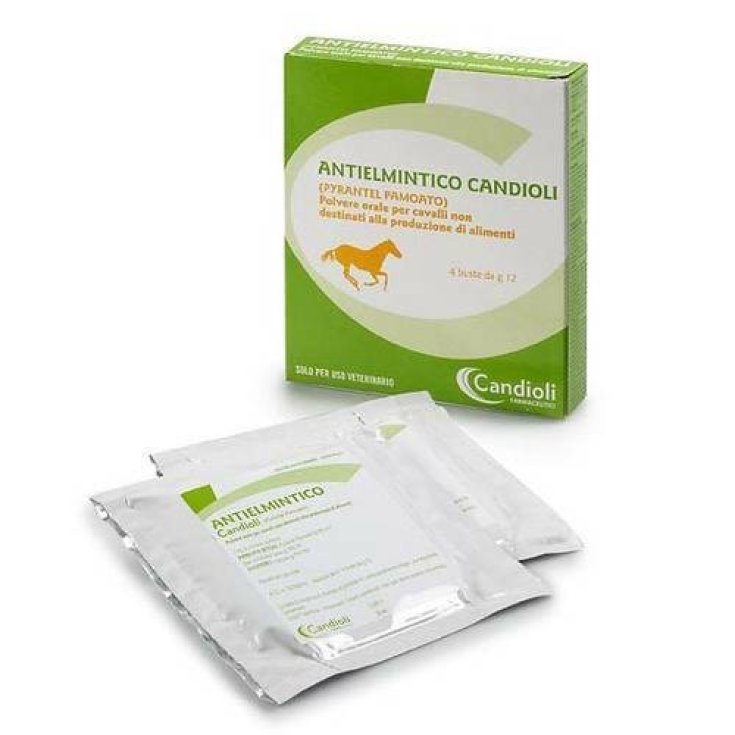Cavalli Candioli Pharma anthelmintic 4x12g

- Brand: CANDIOLI IST.PROFIL.E FARM.SpA
- Product Code: 102168010
- EAN: 8025767000003
- Availability: In Stock
- Purchase 3 items for 19.17€ each
- Purchase 4 items for 18.78€ each
- Purchase 5 items for 18.39€ each
Cavalli Candioli Pharma Anthelmintic Oral Powder
Indicated for the treatment of intestinal parasitic diseases of horses not intended for the production of food for human consumption, caused by large and small strongyles (Strongylus vulgaris, S.equinus, Trichonema spp., Triodentophorus spp.), roundworms (Parascaris equorum), pinworms ( Oxyuris equis) and tapeworms (Anoplocephala perfoliata).
ACTIVE PRINCIPLES
Pyrantel 168.33 mg/g (equivalent to pyrantel pamoate 485.417 mg).
EXCIPIENTS
Lactose.
HOW TO USE
One sachet orally
DOSAGE
The product is to be administered orally, mixing it with the usual food ration and checking that it is completely consumed. Use the packaging that best suits the needs of the treatment to be performed. Administer at the rate of 40 mg of product (equal to 6.733 mg of active principle) per kg of live weight to the animal. For foals aged between two and eight months, one dose is given every 4 to 6 weeks. In adult horses, an administration is made 3-4 days before putting to pasture. In conditions of risk, administer every 4 weeks. In mares, administer 1-2 weeks before foaling, then repeat 1-2 weeks after foaling, then every 6-8 weeks thereafter. In the case of infestations caused by tapeworms (flatworms), the doses should be doubled: in the case of particularly serious infestations, repeat the treatment after 20 days.
INTERACTIONS
The anthelmintic effect of pyrantel pamoate can be antagonized by the concomitant administration of piperazine: avoid the association. In particularly debilitated subjects, the concomitant association of other cholinergic drugs such as levamisole, can generate enhancement of the toxicity of pyrantel.
CONTRAINDICATIONS/SECONDARY EFF
The product is contraindicated in highly debilitated animals or animals with reduced liver function. Do not use in animals with known hypersensitivity to the active substance or to any of the excipients.
SIDE EFFECTS
Mild and transient side effects can occur especially in the gastrointestinal tract such as nausea, vomiting, abdominal pain, diarrhea.
PREGNANCY AND BREASTFEEDING
The medicine can be used during pregnancy and lactation, at the recommended dosages.
WARNINGS
Particular attention must be taken to avoid that the too frequent and repeated use of anthelmintics for a long period of time and the overdose due to an underestimation of the live weight or to an incorrect administration of the product, increase the risk of resistance development and therefore result in the ineffectiveness of the veterinary medicinal product. Suspected clinical cases of anthelmintic resistance should be further investigated by appropriate testing. In the event that the results strongly suggest resistance to an anthelmintic, an anthelmintic belonging to a different class and with a different mode of action should be used. Mix thoroughly with the usual food ration obtaining homogeneity and make sure that all the food available is consumed. Simultaneously treat those horses that frequent the same pasture or space. Carry out the treatment in closed enclosures, with subsequent disinfestation of the soils. The anthelmintic treatment must be carried out after having ascertained the presence of a parasitic infestation supported by parasites sensitive to the action of pyrantel. The copromiscroscopic examination should be conducted before administration of the drug in order to ascertain the consistency of the parasitic load and 15 days after treatment to verify its efficacy. In the absence of clinical signs, it is good practice to establish a threshold below which treatment should not be performed. In the case of foals, the threshold can be established around 150-200 upg of faeces, particularly in the case of roundworm infestations. In mares and adult subjects, an acceptable threshold value is 400-500 upg above which antiparasitic treatment should be carried out. Suspected clinical cases of anthelmintic resistance should be further investigated using appropriate tests. If the results strongly suggest resistance to an anthelmintic, an anthelmintic belonging to a different class and with a different mechanism of action should be used. Special precautions to be taken by the person administering the product to animals People with known hypersensitivity to the active substance should avoid contact with the veterinary medicinal product. Handle the product wearing protective gloves, do not ingest, avoid contact with skin and eyes. Do not eat, drink or smoke while handling the veterinary medicinal product. Wash hands and any other part of the body that comes into contact with the product. In case of accidental ingestion, seek medical advice immediately and show the package leaflet or the label to the doctor. Overdose: There is no danger of overdose due to reduced intestinal absorption. Incompatibilities: In the absence of compatibility studies, do not mix with other veterinary medicinal products.
FORMAT
Pack with 4 sachets of 12g.

